Grieving the sudden loss of Sharath Jois & what it was like to study with him in Mysore, India.
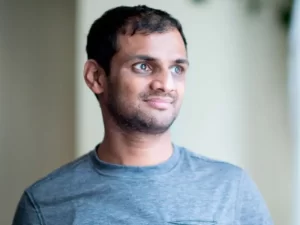 It has been nearly four months since my guru and yoga teacher, Paramaguru Sharath Jois, unexpectedly passed away while hiking on Humpback Rocks in Charlottesville, VA.
It has been nearly four months since my guru and yoga teacher, Paramaguru Sharath Jois, unexpectedly passed away while hiking on Humpback Rocks in Charlottesville, VA.
His loss was a jolt to the international Ashtanga yoga community. Many of his dedicated students traveled annually to India to study under his guidance over the last ~35 years.
Prior to his passing, he had been teaching in the U.S. for several weeks in Miami and New York. The training in Charlottesville was a special teacher training for authorized and certified Ashtanga yoga students who had studied with him extensively at Sharath Yoga Centre in Mysore, India. I was among those who had traveled to Virginia for the training.
Paramaguru Sharath Jois was the premier teacher of Ashtanga yoga and the lineage holder, having learned from his grandfather, K. Pattabhi Jois, dubbed the “founder of Ashtanga.” His students affectionately referred to him as “Sharathji” or “Guruji.”
Grieving is a process, and I am still going through it. About 65 of us were on the hike with him that day, and around 100 people came from all over the world for the special training of the new Active Series he had developed and was introducing. We had two days of regular yoga practice and learning from him and three more of mourning our profound loss.
As sad as I am over his passing, I can’t imagine what his family is going through. I wish them all peace and comfort in the memories they shared with him. He was only 53 years old. He left behind his loving wife, Shruthi, daughter Shraddha, son Sambhava, and mother Saraswathi.
He was seemingly perfectly healthy minutes before his passing. He was a skilled photographer and had set up his camera on a tripod to film each of us as we entered the trail on the Blue Ridge Parkway. We all thought we were waving hello to him, but it turned out to be our last goodbye.
Most of us began the trek up the mountain and assumed he was behind us. We reached the peak and began taking photos, wondering what was taking our guru (and a few other students with him) so long to join us. But they never reached the top of the mountain. I thought maybe someone had twisted their ankle or perhaps went on another path to take photographs. After some time, we began to go back down the hill. I walked alone on my way down, being my usual reclusive self, and took this photo of the sun setting over the steps of the mountain. I now hold this photo very dear to my heart, as I think of it as the last light of dear Sharathji.

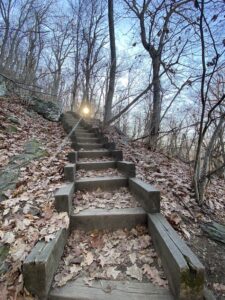 Soon after taking that photo, I reached our group, gathered in the woods. We were initially told there was an accident and that it was quite serious, but we did not know who had suffered the “accident.” But it was suggested that we all join hands, pray, and wish good thoughts. We did this for several minutes while we waited to hear more news. Our holding hands together was a very peaceful moment. Everything seemed calm.
Soon after taking that photo, I reached our group, gathered in the woods. We were initially told there was an accident and that it was quite serious, but we did not know who had suffered the “accident.” But it was suggested that we all join hands, pray, and wish good thoughts. We did this for several minutes while we waited to hear more news. Our holding hands together was a very peaceful moment. Everything seemed calm.
And then the very bad news reached us. Or rather, it slowly became evident to many of us that what had occurred was the absolute worst, unfathomable thing. How could this possibly be? We just saw him. He was smiling.
The rest of the walk down the trail was harrowing, past the bench where he had sat down when he began feeling ill and where his covered body lay peacefully with the EMTs surrounding him. It was another 15-minute walk to the bottom, to the anguishing cries of his students, my tears silently falling in disbelief.
Autumn’s wind blew cold, rustling the yellow leaves over my head. I looked to the sky. A surreal vacuum of emptiness shrouded our side of the mountain, the same hollow feeling I felt at the time of my father’s passing two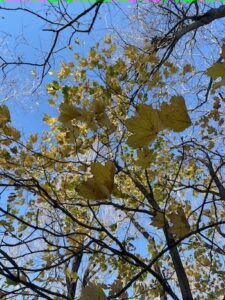 years prior after my Mom and I tried giving him CPR. Both Sharathji and my Dad were larger-than-life forces. And to have them suddenly sucked from my presence left a barren void.
years prior after my Mom and I tried giving him CPR. Both Sharathji and my Dad were larger-than-life forces. And to have them suddenly sucked from my presence left a barren void.
I couldn’t make sense of what had just happened. All I felt was a terrible and mean anger boiling. I had come to see my guru because I missed him and needed reinforcement in my practice. I craved his good energy, that light in his eyes. In these times, it often seems like the world is falling apart. There are many injustices and tragedies and a lack of compassion for others. I needed my guru to help me make sense of the world again; now he was gone.
“This stupid, awful shitty world,” I teemed to myself as I slowly trudged down the trail. “I hate this fucking place. It takes everything good from it.”
I wanted to bash my fists into the innocent trees, but sweet Bianca was at the bottom of the hill, and she gave me a big hug, so I hugged her back instead. “I don’t understand; I don’t understand,” I said.
hug, so I hugged her back instead. “I don’t understand; I don’t understand,” I said.
I know from experience that anger is a step in the process of grief, the others being denial, bargaining, depression, and acceptance. I guess I went straight to anger that day.
I looked around at the many sad faces, all still in disbelief. There was an ambulance, medics, and police. We shivered in the cool air as the sun went down, not knowing what to say or do next. How can the life and light in someone suddenly vanish? We were all in shock.
 The cause of death was a massive heart attack. Several of his dearest students were with him at the time and administered CPR. Most of us had hiked to the top of the mountain, admiring the view, not knowing what was happening below.
The cause of death was a massive heart attack. Several of his dearest students were with him at the time and administered CPR. Most of us had hiked to the top of the mountain, admiring the view, not knowing what was happening below.
In the days that followed, people around the world and online were in shock and questioned how such a healthy person could die so young; some cynically even questioned the validity of the practice itself, or worse, his character – as if death does not come for us all eventually. Two quick things on that: One, Sharathji had terrible rheumatic fever as a child, a known factor in causing heart problems later in life. Second, he did more for others in his short lifetime than most of us could ever do in 100 lifetimes. Showing up for hundreds of people daily, helping them believe in themselves, and giving them a healthy tool they can use for the rest of their lives – and teach to others – is far more impactful than having one million followers on Instagram who mindlessly click through your posts and forget you in the next second.
What held our group of 100 students together over the next few days that we were supposed to have the training was the community he built and the practical tool he gave us – Ashtanga yoga. I have never been so touched as I was in those days by the people I met at that training – all comforting each other and lifting each other up in a time of deep sadness and trauma.
Ashtanga practitioners tend to be a little aloof at times, but what I found in those couple of days after was a warm, inviting community that came together with empathy and deep love of our dear Guruji.
***
I wish I had dared to connect more with Sharathji while he was alive, but I was always too nervous. I wish I had thought of something to say to him that morning when he came into the room. Maybe as simple as “So glad I am here with you, Guruji!” I naively thought he would always exist and there was plenty of time to have more connections with him.
And I regret being too skeptical. “Is he the real deal or not?” I sometimes wondered to myself. And then think, “He must be the real deal since I have traveled to the other side of the world to study with him.” I was not even a yoga teacher. I had
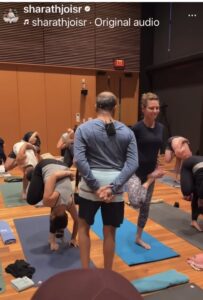
nothing to gain besides better health (physical and emotional). But over a period of twelve years, if I had a chance to spend time with him, I went. I pilgrimaged to India four times, for several weeks each time. I also traveled to practice with him in Madrid, Miami, Los Angeles, and New York City. In fact, I have not really vacationed anywhere unless he would be there, LOL! And there is nothing and nowhere in the world I would have rather done or gone.
“Who is going to fix me now?” I cried to my sister on the phone the day after he died.
Of course, I know making him responsible for “fixing” me is a little extreme, but practicing under him has always been like a reset for me. It required dedication, stamina, perseverance, and discipline. Those things keep me steady, even off the yoga mat.
I have never talked much about my personal experiences with Sharathji nor written much publicly about him. I wasn’t planning on writing anything about his passing. But now I am reading and watching things people post online since he passed, and I want to share what he meant to me (and so many others).
I want people to know what I know about my guruji, Sharath Jois
It’s not that I knew Sharathji so well outside of our student/teacher relationship (I didn’t). But every time I returned to Mysore, I felt he knew me. Because he would remember things like “back still jammed” after not seeing me for two years, even though he had seen hundreds, if not thousands, of students in the meantime.
He noticed if I missed a day or two of practice. He watched my yoga practice, knew my yoga practice and my bodily limits, and made sure I did the poses correctly without hurting myself or overstretching. But still, he pushed me always to do more and do better. He knew my limits better than I did. He also helped me progress in subtle ways, like being more playful with practice and not taking it so seriously. He would make me laugh in Navasana (boat pose) – how is that even possible?! He often had a twinkle in his eye.
I was no more special than anyone else in the room – far from it. But he had a unique way, some even call it “magic,” that made us each feel special, even among hundreds of other students. He paid attention to our practice, knew exactly what we were doing and when, and steered us in the right direction. He talked very little; he watched us a lot.
The way teaching yoga in India works is not our Westernized approach, where we all enter the room at the same time and uniformly practice together at the same speed and tempo. In India (and at certain shalas worldwide), we do “Mysore-style” yoga, which is named after the city in India where Ashtanga became popular. In Mysore-style yoga, you enter the room one by one, as called upon when someone else finishes, and do a self-practice, which is in a structured sequence, from memory. You go at your own speed, in your own breath, while your teacher watches, corrects, and provides adjustments.
His students bestowed the title “Paramaguru” upon him. This title means that he was the current lineage holder of the practice of Ashtanga, as taught to him by his grandfather, K. Pattabhi Jois, who learned it from Krishnamacharya. This lineage holds value for everyone with authorization and certification by Sharath Jois. It is through this lineage that authenticity – that truth – separates real yoga from the circus. If his students fail to see the value in the lineage, they fail to see the value in themselves. When I think about how lucky I was to have found this yoga practice and to have studied under him, I realize it was a precious gift from the Universe.
In all the conferences I attended with Sharathji, where he spoke to us on many different topics, from the existence of God to how to put your hands in a headstand, I never heard him once talk bad about someone else. Lord knows there are terrible yoga teachers, some with many followers, but I never heard him call out anyone by name. I never heard him talk negatively at all.
God to how to put your hands in a headstand, I never heard him once talk bad about someone else. Lord knows there are terrible yoga teachers, some with many followers, but I never heard him call out anyone by name. I never heard him talk negatively at all.
I did hear him warn us of certain behaviors, and he made sure we knew the difference between true yoga and a circus – handstands, flying yoga, goat yoga, naked yoga, beer yoga – “This is all just a circus,” he would say. However, I never heard him say the circus was “bad” – but it was not authentic yoga. Because of his teachings, I understand the difference between yoga, the SCIENCE of self-realization, which is passed down through tradition, and other “Westernized” versions of playful stretching that some people call “yoga.” I’m not saying I’ll never try “Goat yoga!” It does sound fun!! But it is not the spiritual and scientific practice of yoga.
In the days after Sharathji’s passing, things in my life were suddenly made very clear to me that I had chosen to ignore before.
I am sad that I took my time with him for granted. It was an abrupt reminder not to take time in general for granted. We do not know how much time we have or when we will lose the people we love. I have been wasting far too much time, not focused and not motivated and not doing things with clear intentions. Time to reign it all in.
Over many years, I have seen people ignoring things he said – repeatedly – and then wonder why the practice was not working for them, why he was not perfect. I am not immune to this myself. I’ve also seen people try to make him a saint, idolize him, etc. These things never worked on him. He knew his truth and his duty and performed it well. He steered clear of adulation and forgave our forgetfulness, ignorance, and faults. If he had any failings that I could see, they were those we projected on him or could not grasp. But he never demanded anything of us except maybe respect – for the practice, others, and ourselves.
He could have been much more famous, much more prosperous, etc. However, what he chose to do every day was not to bring attention to himself but to work hard every day and help others realize their true selves and their true potential. “The greatest gift you can give anyone is good health,” he said.
If some students put him on a pedestal, I don’t know – maybe it’s because he deserves one. I don’t personally know any other human being who gave that much of himself to his students day in and out for 30-some years.
Sharathji was the most humble person I have ever met
and the greatest force of goodness I have ever personally known
He was such a gentle soul. One day, while practicing at the crowded Gokulum shala years ago, I saw him moving quietly through the maze of yoga mats filled with students. At first, I didn’t understand what he was doing, but then I realized he was gently trying to nab a cockroach in his palm. He did and then safely discarded it outside. He did not want to harm the curious creature (or disrupt the yoga class!)
Did he make mistakes? I’m sure, but I don’t know. I did not see any mistakes that were not corrected. And anyway, it’s not for me to judge but to share my perspective on what he meant to me, how he made me feel, and how he made my life better.
Another testament to the goodness he gave the world is the strength of the community he left behind. We were all devastated that day in Charlottesville, but we all stayed on there – in a strange city and comforted each other. We grieved with each other. We did our practice together. We waited for his wife and son to arrive for the funeral held in Charlottesville.
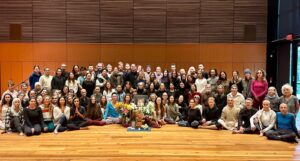
He died on November 11, 2024, but the shala in India was set to open on December 1st. Many students already had their travel arrangements planned for going to India. So his wife and family graciously opened the shala, and students went to practice there. They plan to keep the Sharath Yoga Centre shala running and his legacy moving forward.
There is something very special about practicing alongside such dedicated students. I am not an advanced yoga student by any stretch, but I have never been made to feel like I was less of a yoga student by Sharathji or by his other advanced students, some of them doing astrodynamical poses next to me. There is good energy when surrounded by people with the same intention, which boils down to this: to understand ourselves better.
When we know ourselves better, we can be better people. In turn, we can help each other improve, ultimately making the world more enjoyable.
“What’s the purpose of life?” a student once asked Sharathji.
“To enjoy it!” he replied.
I wrote the following on my social media on the day of his funeral:
For Sharathji’s 50th Birthday (during Covid times), his students from around the world put together this video message:
- God and My Dad, Jesus - March 24, 2025
- My First Trip to Study with Sharath Jois in Mysore India - March 18, 2025
- Sharath Jois, Ashtanga Yoga Guru (1971 – 2024) - March 5, 2025

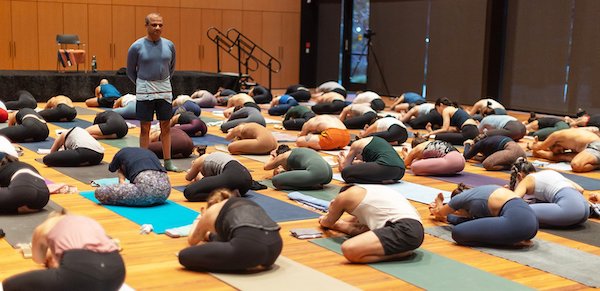
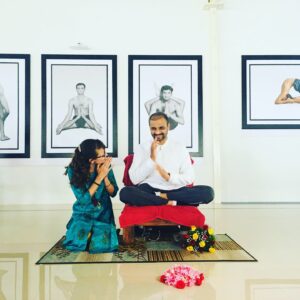
1 thought on “Sharath Jois, Ashtanga Yoga Guru (1971 – 2024)”